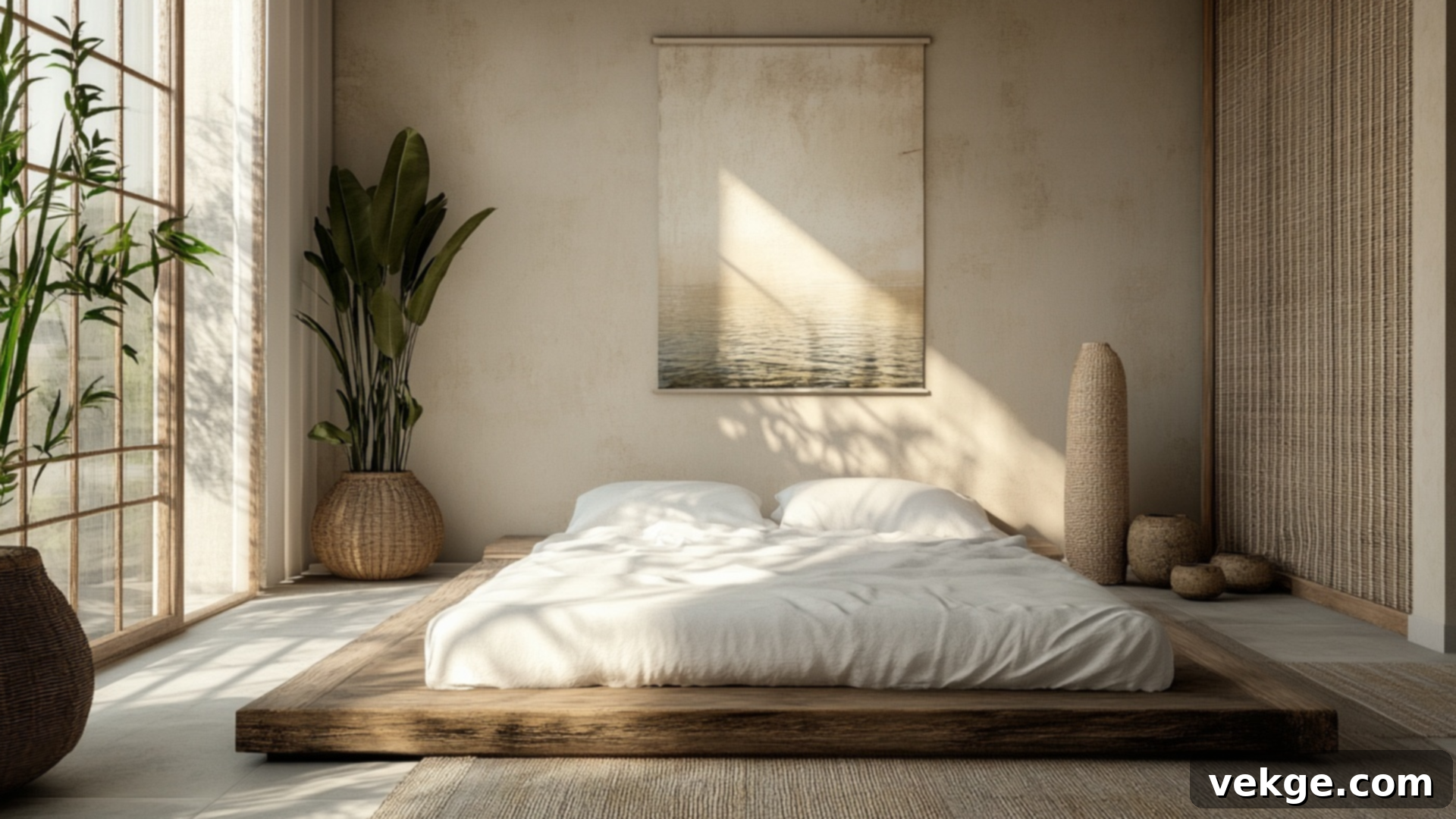Transform Your Bedroom: Master Feng Shui Layouts for Serene Sleep and Positive Energy
Have you ever found yourself wondering why your bedroom doesn’t quite feel like the peaceful retreat it should be, even after it’s been thoroughly cleaned and tidied? I’ve been there, too. It’s a common experience, and often, the reason goes beyond simple clutter. The way your personal space is arranged—its layout and the energy (or “Qi”) that flows within it—can subtly but powerfully impact your sleep quality, mood, and overall sense of well-being. A bedroom is more than just a place to sleep; it’s a sanctuary where you recharge your body and mind.
For years, I used to wake up feeling unrefreshed and tired, despite getting what I thought was a full night’s sleep. This frustrating cycle only truly shifted when I began to explore and apply a few straightforward Feng Shui bedroom ideas focused on positive energy placement. These principles, rooted in ancient Chinese art and science, transformed not just my bedroom but also how I felt within it and how deeply I rested.
Simple adjustments, like strategically shifting the position of my bed, optimizing the lighting to create a softer ambiance, and carefully selecting calming colors for my decor, completely changed the feel of my space. The result was a dramatic improvement in my sleep and a greater sense of peace and comfort when I was in my room.
In this comprehensive guide, I’m excited to share easy-to-implement Feng Shui tips that will help you bring harmonious energy into your bedroom. You don’t need expensive furniture or a complete room overhaul to make a significant difference. With these practical insights, you’ll learn how to create a bedroom environment that truly supports rest, relaxation, and rejuvenation, allowing you to wake up feeling energized and ready to face each day.
What Feng Shui Can Do for Your Sleeping Space and Overall Well-being
Feng Shui, which literally translates to “wind-water,” is an ancient Chinese art and science focused on arranging environments to optimize the flow of energy, known as “Qi” (pronounced “chee”). In the context of a bedroom, Feng Shui goes beyond mere aesthetics; it’s about creating a space that nurtures your physical and emotional well-being. A thoughtfully arranged room can significantly enhance your body’s ability to rest and your mind’s capacity to relax, leading to profound benefits.
Here’s how integrating Feng Shui principles into your bedroom design can positively impact your life:
- Better Sleep Quality: By ensuring a clear, unobstructed path around your bed, utilizing soft, dimmable lighting, and choosing serene color palettes, Feng Shui signals to your brain that it’s time to unwind. This encourages deeper, more restorative sleep cycles, helping you wake up feeling truly refreshed.
- Reduced Stress and Anxiety: A neat, balanced, and harmonious bedroom layout naturally promotes a sense of order and tranquility. This calm environment can significantly help in lowering anxious thoughts and mental clutter, fostering a peaceful mind before sleep.
- Improved Mental Clarity and Focus: When your sleeping space is optimized for peace and energy flow, you tend to experience less mental noise. Waking up in a serene environment helps clear your mind, leading to enhanced focus and concentration throughout your day.
- Increased Comfort and Security: Proper furniture placement, especially for your bed, ensures that your room feels cozy, secure, and supportive. This sense of safety is fundamental for deep relaxation and allowing your body to fully let go and rest.
- Healthier Energy Flow: Minimizing the presence of electronics, maximizing natural light, and incorporating elements of nature help to circulate positive, life-affirming energy. This creates a space that feels lighter, calmer, and more conducive to healing and rejuvenation.
Practical Feng Shui Bedroom Ideas for Positive Energy Placement
Achieving a balanced Feng Shui bedroom layout is essential for supporting rest, fostering deep relaxation, and nurturing emotional well-being. By thoughtfully placing your bed and other furniture, you can create a truly peaceful space filled with positive energy, making your room a calm, supportive haven perfect for recharging at the end of each day. Let’s explore key strategies for optimal energy flow.
1. Strategic Bed Placement for Stability and Openness
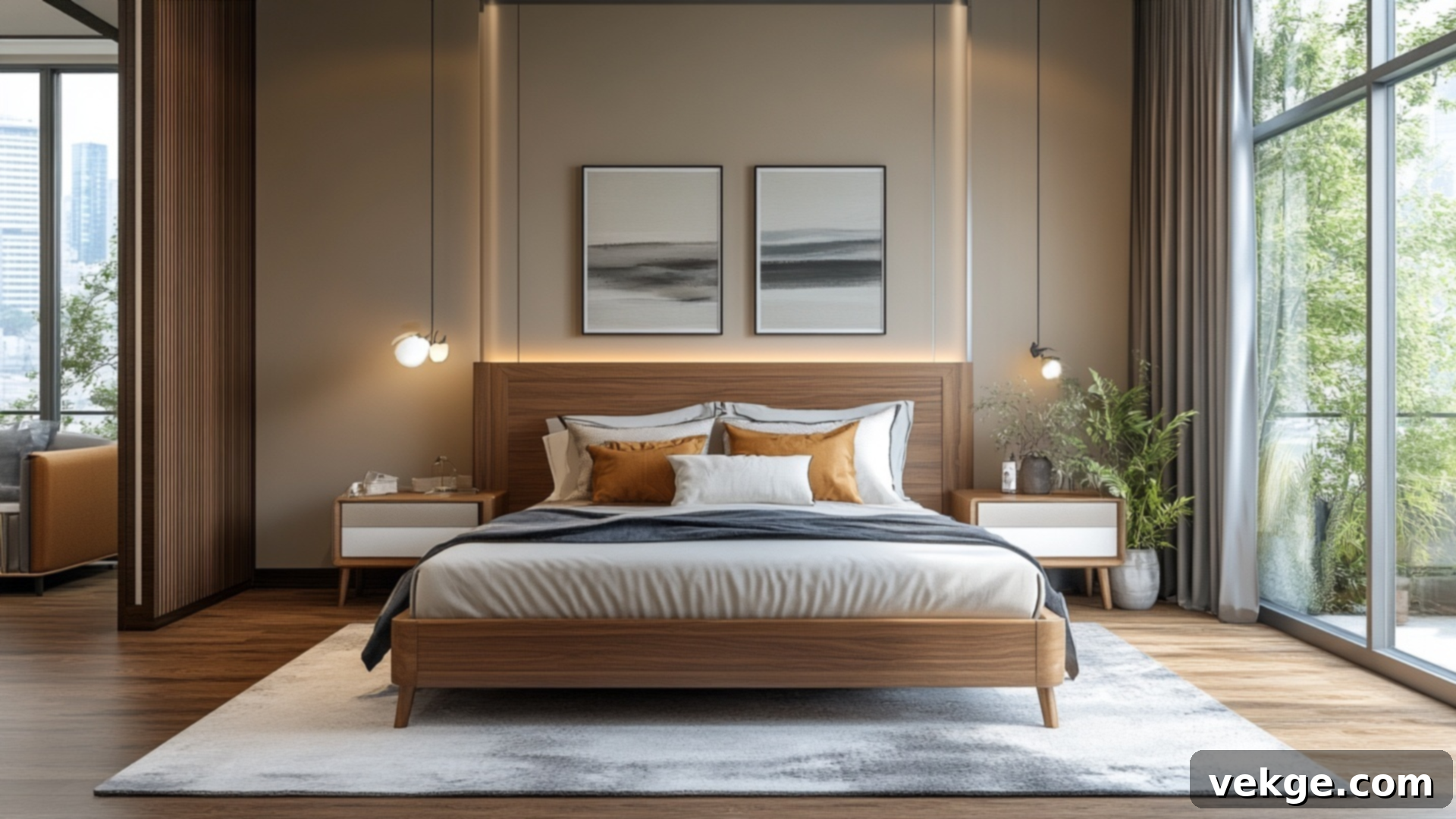
In Feng Shui, the precise location of your bed holds immense importance. It’s not just about where it fits best; it’s about how its position influences the flow of energy and your sense of security. Your bed should be placed in a way that allows for an open, unhindered space around it, ideally against a solid wall. This placement brings a vital mix of safety, calmness, and a subtle sense of control to your room, fostering a supportive environment for truly restful sleep.
2. Embrace the Commanding Position
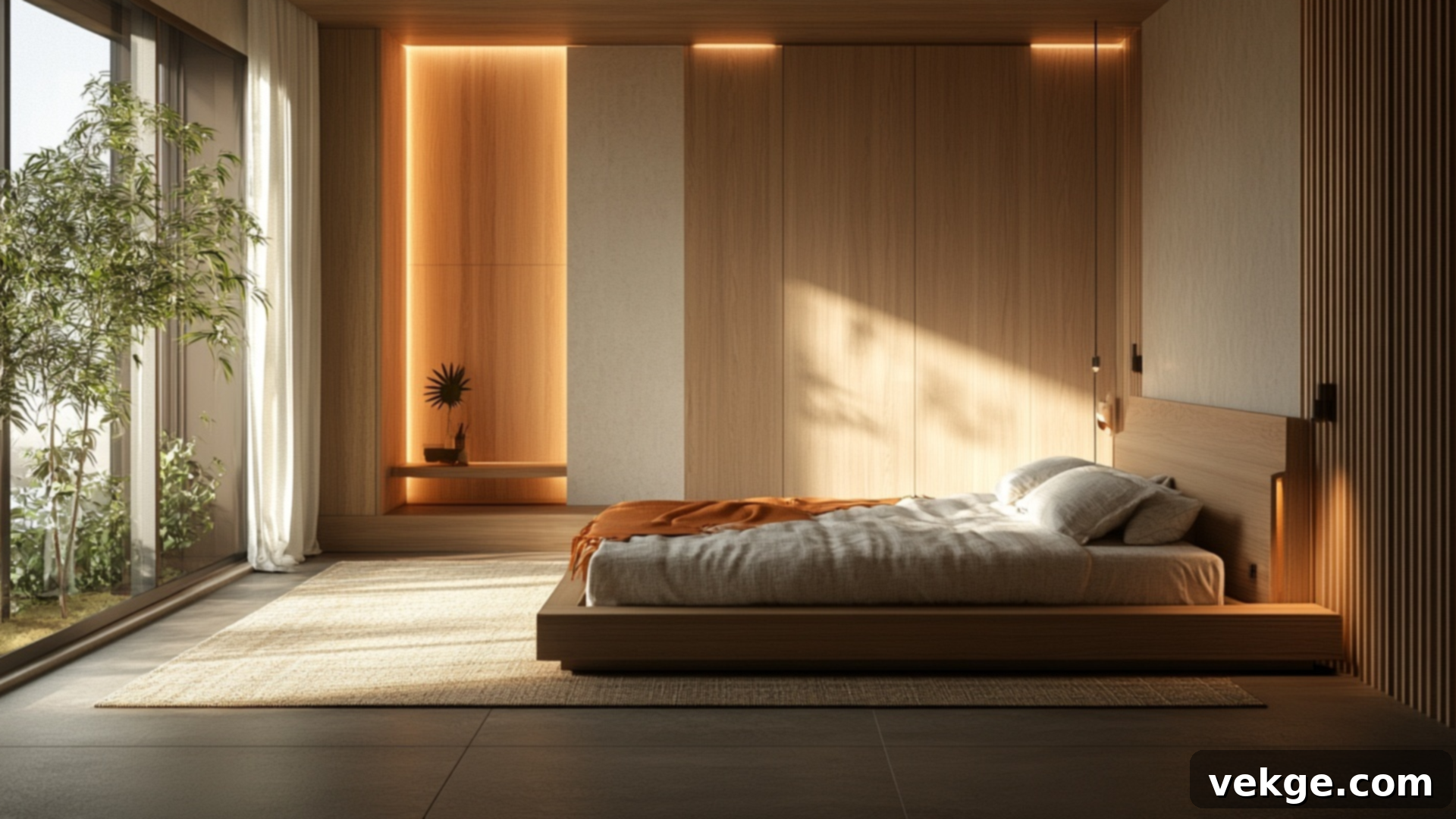
The “commanding position” is a cornerstone of Feng Shui, meaning your bed should allow you to see the bedroom door without being directly in line with it. When you lie down, you should have a clear, unobstructed view of the entrance to your room. This strategic setup helps your mind relax because it eliminates the subconscious stress of not seeing who or what is entering your space. Feeling safe and protected during rest is crucial for deep, uninterrupted sleep, allowing your body to fully rejuvenate.
3. Choose a Solid, Supportive Headboard
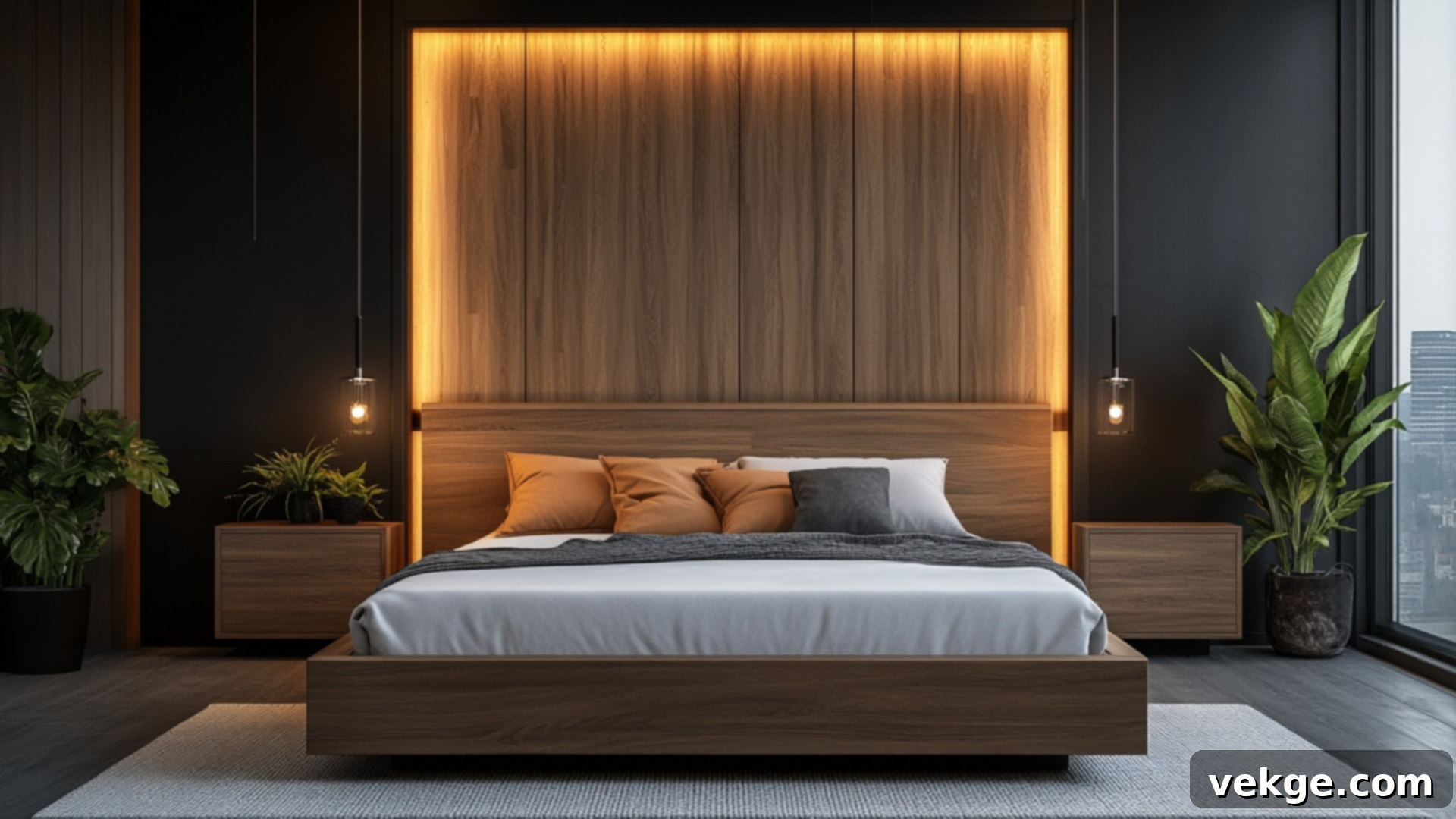
A strong, solid headboard—one that is fully supportive rather than being made of bars or having large gaps—provides a crucial feeling of support and stability to your bed. In Feng Shui, this translates to robust emotional and physical grounding, mirroring the support offered by a solid wall behind you. It helps anchor your energy while you sleep, preventing it from scattering and instead promoting a deeper, more peaceful, and secure rest. Opt for materials like wood or an upholstered headboard for maximum support.
4. Cultivate Symmetry and Balance

Balance is a fundamental principle in Feng Shui, especially in the bedroom. To achieve this, place matching nightstands or small tables on both sides of your bed. Complement this with matching lamps or other decorative elements. This symmetrical arrangement ensures that energy moves evenly and harmoniously through the room, creating a sense of stability and equality. This balanced setup provides a clean, calm, and visually soothing feeling that deeply supports your mind and enhances the quality of your sleep, promoting overall peace.
5. Choose Soothing, Calming Colors
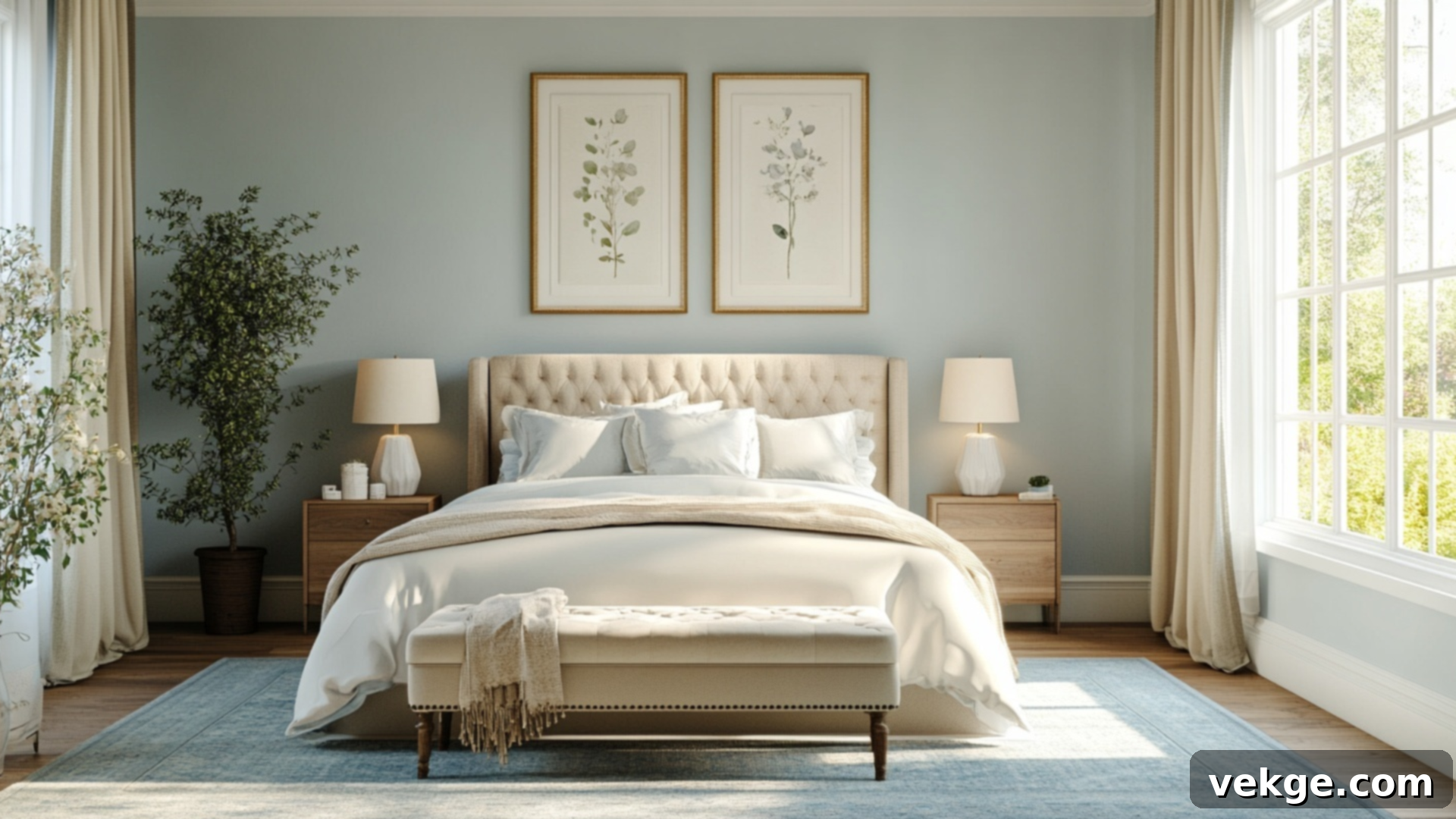
The colors in your bedroom play a critical role in influencing your mood and sleep. Feng Shui strongly advocates for soft, muted colors that promote tranquility. Shades like light blue, pale green, soft brown, gentle grays, or warm off-whites are ideal. These soothing tones help to calm an overactive mind and encourage your body to slow down and prepare for rest at night. It’s important to avoid vibrant, loud, or overly dark colors in the bedroom, as they can stimulate your mind, make you feel restless, and disrupt the peaceful energy necessary for sleep.
6. Opt for Soft and Gentle Lighting
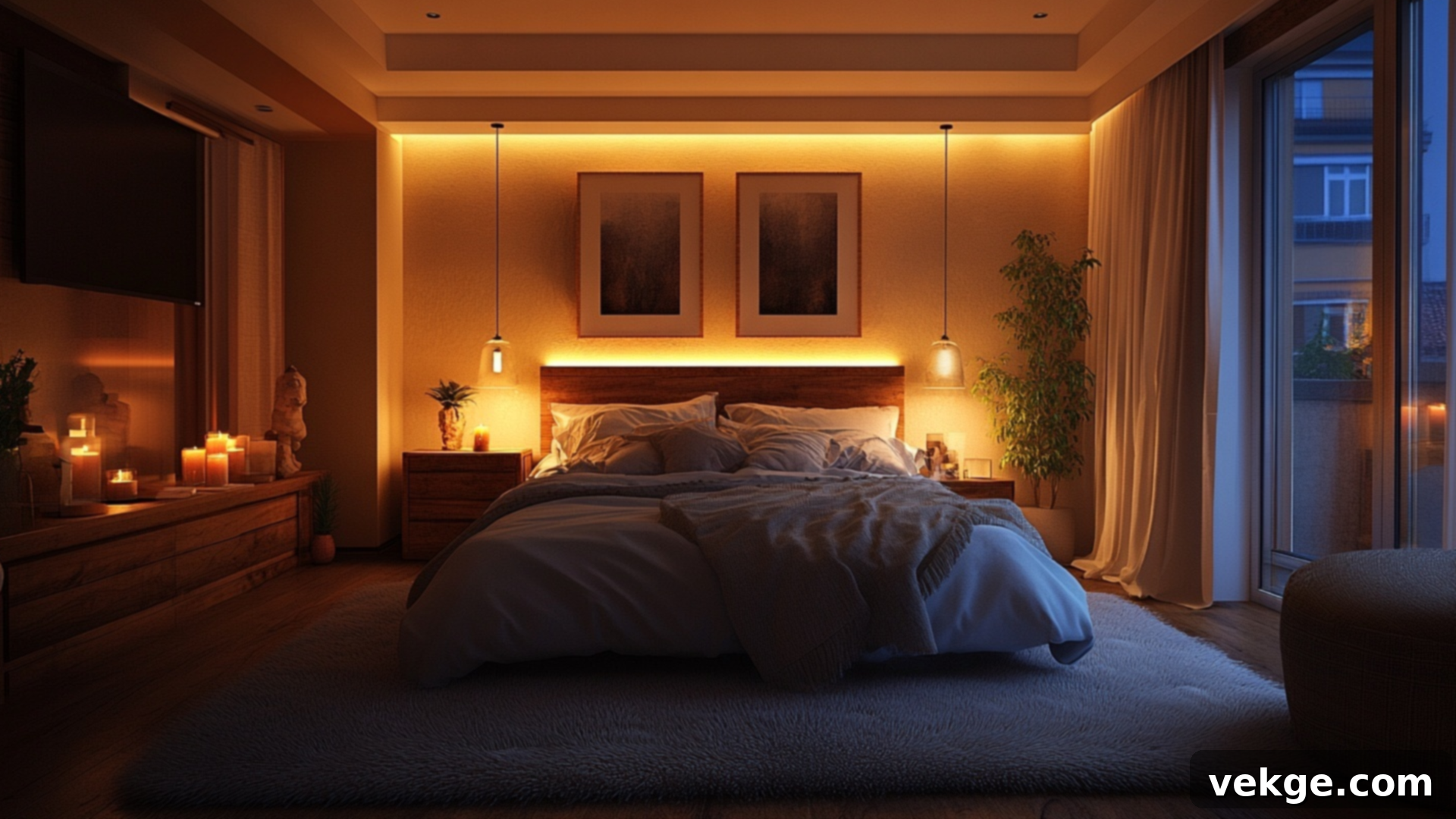
Harsh overhead ceiling lights can be jarring and make it difficult for your body and mind to truly relax. Instead, cultivate a serene atmosphere with warm, gentle, and diffused lighting. Utilize dimmable table lamps, wall sconces, or even strategically placed candles (with safety in mind) to create a cozy and inviting glow. This softer illumination signals to your body that it’s time to wind down and prepare for rest. A gentle glow not only calms your thoughts but also profoundly supports deeper, more peaceful sleep, essential for waking up refreshed.
7. Avoid Mirrors Reflecting the Bed
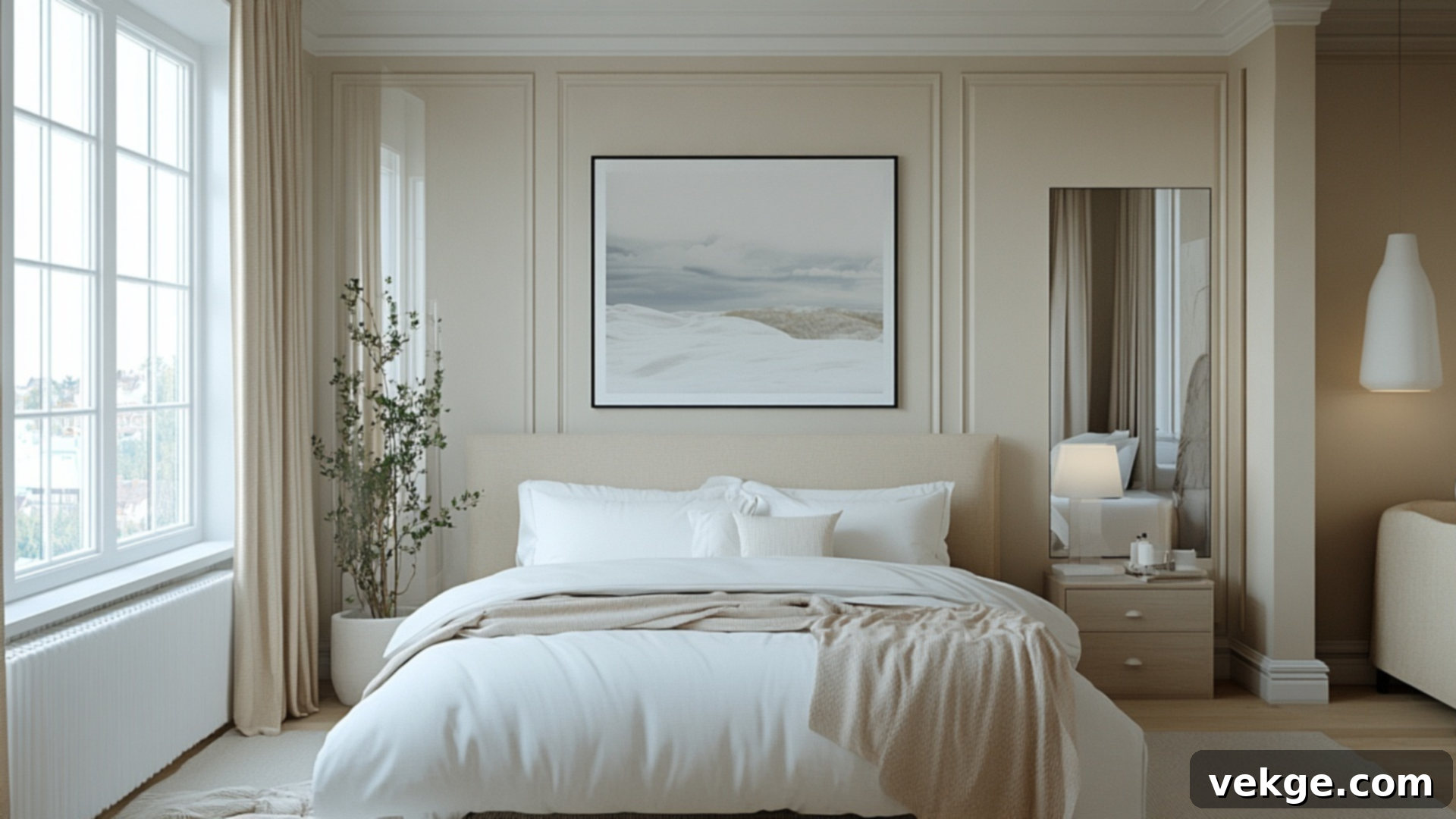
In Feng Shui, mirrors are powerful energy activators that can bounce and amplify energy. When a mirror directly faces the bed, it can create a sense of restless energy, keeping your mind inadvertently alert and potentially leading to disrupted or poor sleep. It can also symbolize the presence of a “third party” in a relationship. If you have a mirror in your bedroom, strategically place it so it does not reflect your bed. As an alternative, you can cover it with a cloth or screen at night to create a more peaceful and undisturbed sleeping space.
8. Implement Sound and Noise Control
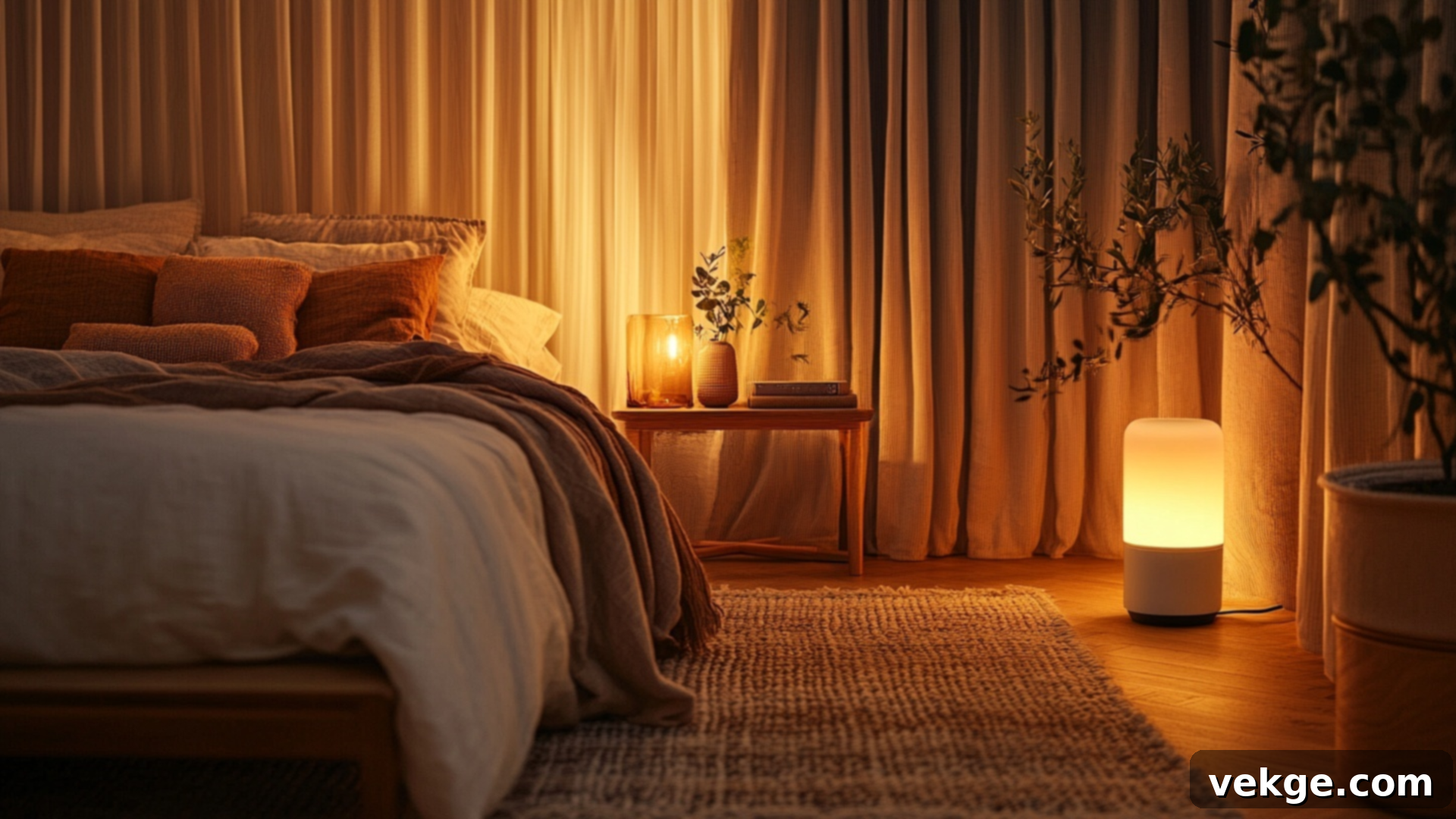
Excessive or sudden noise can keep your brain active, making it incredibly difficult to relax and fall asleep. To minimize auditory distractions and promote a quiet environment, consider using thick, insulated curtains, installing soft, plush rugs or carpeting, or utilizing a white noise machine or a fan to create a soothing, consistent background sound. A quiet room helps your body and mind disengage from daily stresses and rest more effectively. Maintaining low noise levels supports a peaceful and secure feeling in your bedroom every night.
9. Keep the Head Space Above the Bed Clear

It’s best to avoid placing shelves, heavy artwork, overhead storage, or any other substantial objects directly above your bed. Subconsciously, the weight and presence of these items can create a feeling of pressure or tension, even while you’re asleep. In Feng Shui, maintaining clear, open space above your head allows energy to flow smoothly and lightly. This cultivates a vital sense of freedom, security, and spaciousness, which are crucial for truly relaxing and achieving deep, restorative sleep without any lingering feelings of being weighed down.
10. Incorporate Natural Materials and Elements

Bringing elements of nature into your bedroom helps to create an intrinsically soft, peaceful, and grounding atmosphere. Consider incorporating wooden furniture, adding lush houseplants (chosen carefully for the bedroom environment), or displaying simple artwork depicting natural landscapes, trees, or calm waters. These natural elements help to keep the room’s energy balanced, clean, and vibrant. Incorporating natural items makes your space feel more alive, fresh, and deeply beneficial for your overall physical and mental well-being, connecting you to the earth’s calming energy.
11. Ensure Proper Airflow and Ventilation

Fresh, circulating air is crucial for keeping the energy (“Qi”) in your room vibrant and healthy. Stale air can accumulate stagnant energy, making the room feel heavy, sluggish, and less inviting. Make it a habit to open your windows regularly to allow fresh air to flow through, or use a quiet, oscillating fan to maintain gentle air movement. Good airflow not only helps you breathe better but also ensures that the energy feels light and dynamic, contributing to a more refreshed feeling when you wake up each morning.
12. Maintain Bed Accessibility from Both Sides
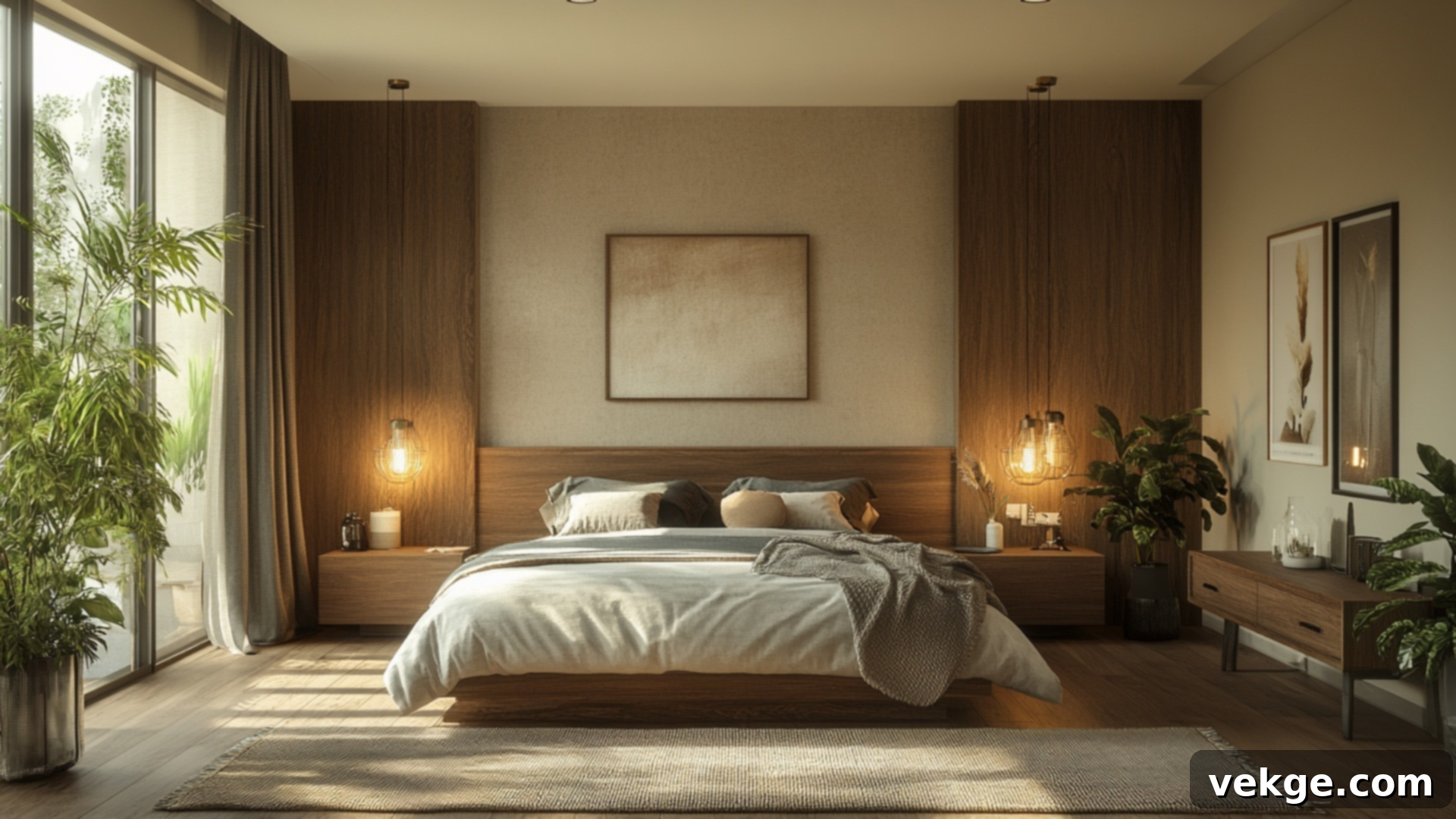
For optimal Feng Shui, your bed should ideally be easily accessible from both sides. This arrangement fosters a sense of balance and equality within the room, allowing energy to move freely and evenly around the bed. From a practical standpoint, it also ensures that both partners, if the bed is shared, have equal space, comfort, and ease of access, promoting harmony in the relationship. A balanced and easily accessible bed setup is key to creating a more peaceful, supportive, and fair sleeping environment.
13. Avoid Sharp Angles and Pointy Furniture
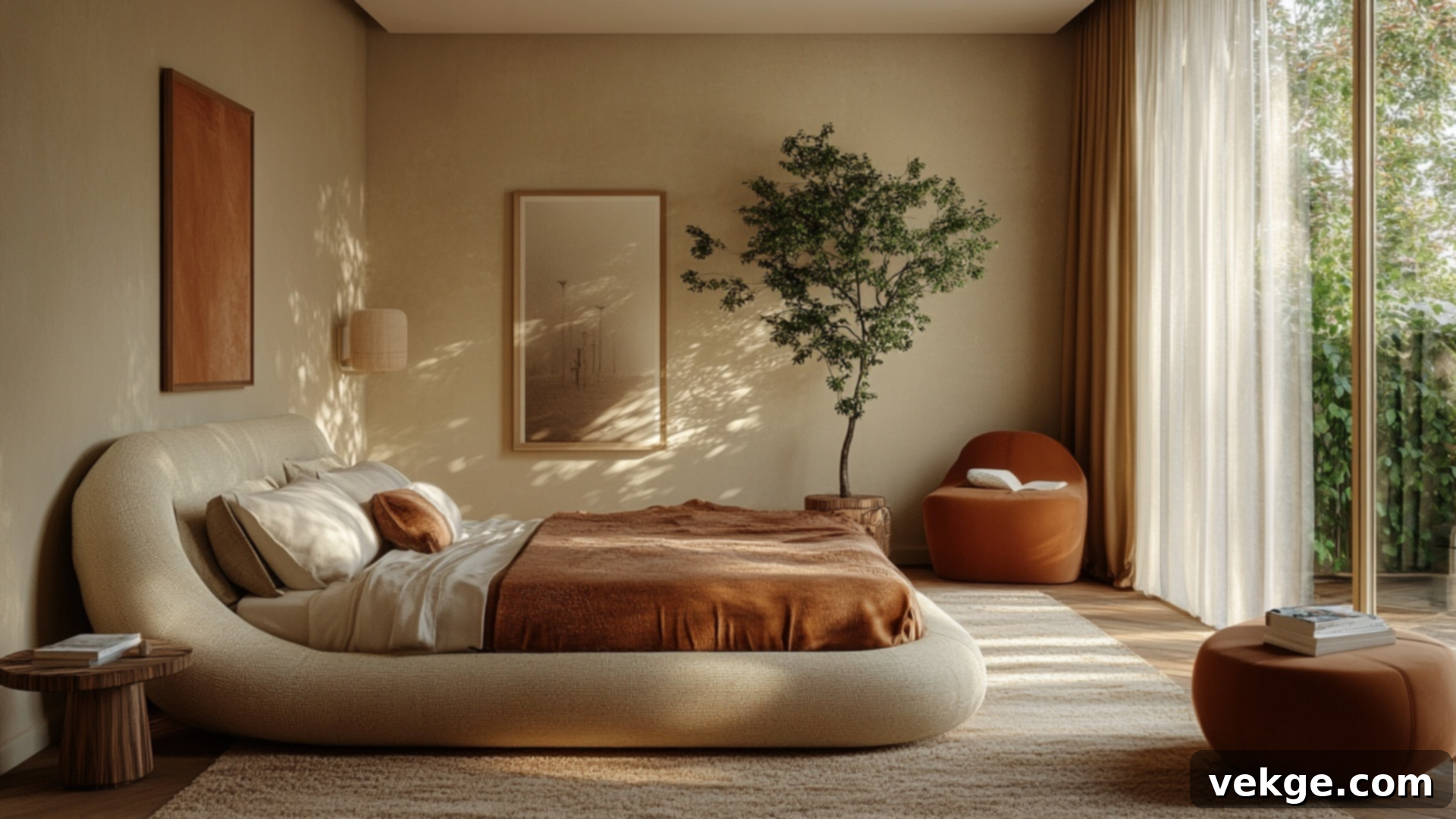
Pointy edges or sharp angles on furniture can create a subtle, yet tangible, feeling of tension and unease within a space. In Feng Shui, these sharp corners are believed to emit “Sha Chi,” or cutting negative energy, which can disrupt tranquility and lead to discomfort. Whenever possible, opt for furniture with soft, rounded shapes or gently curved corners. If you have existing furniture with sharp edges, consider softening them with plants or strategically placed fabric. This practice helps to create a safer, calmer, and more flowing environment, allowing your mind to relax completely when you’re seeking rest.
14. Balance the Five Elements for Harmony
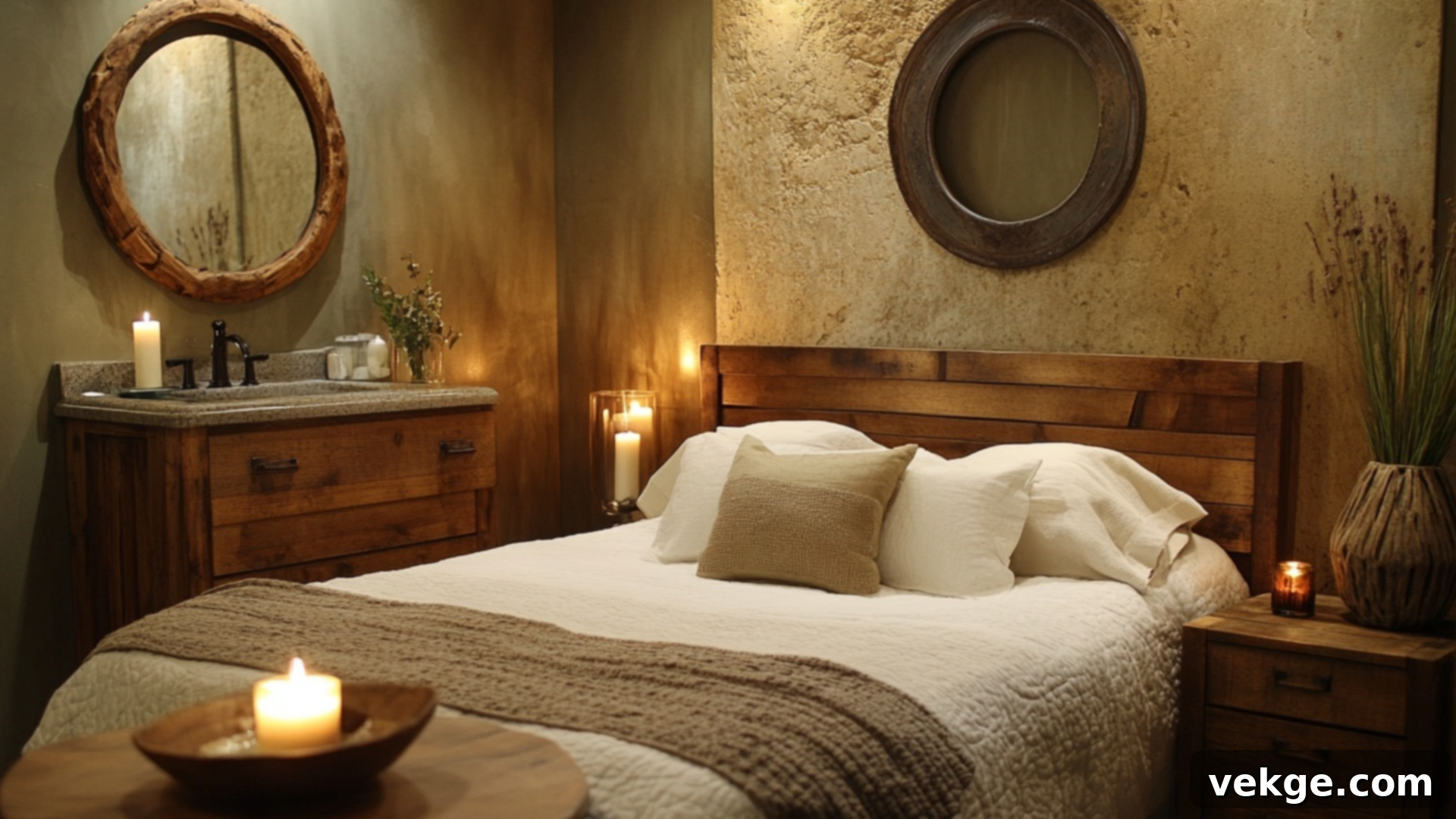
Feng Shui integrates five fundamental natural elements: Wood, Fire, Earth, Metal, and Water. Achieving a subtle balance of these elements in your bedroom helps to create a deeply harmonious and stable environment. You can introduce these elements through various decor items: Wood with a sturdy bedside table or plant; Fire with a small candle (used safely) or warm lighting; Earth with ceramic pots, stones, or earthy tones; Metal with a simple metal frame or decor; and Water with a small, still bowl of water or wavy patterns. Incorporating a little of each element ensures the room feels grounded, balanced, and energetically complete.
15. Surround Yourself with Soft, Inviting Fabrics

The tactile experience of your bedroom environment significantly contributes to your ability to relax. Choose soft, comfortable, and luxurious materials for your bedding, throws, rugs, and curtains. Fabrics like organic cotton, linen, silk, or plush velvet help to soothe your body and invite deep relaxation. They also make the room feel incredibly gentle, cozy, and inviting. In Feng Shui, soft textures calm the senses and contribute to creating a sanctuary where you can truly unwind, fully rest, and completely recharge your energy, enhancing your overall comfort and peace.
How to Put These Feng Shui Principles into Practice: A Step-by-Step Approach
Understanding Feng Shui principles is the first step; actually applying them to transform your space is the next, and most rewarding, part of the journey. Don’t feel overwhelmed by the number of tips. Here’s a practical, actionable approach to integrate these ideas effectively into your bedroom:
- Prioritize the Bed First: Begin by focusing on your bed. Reassess its position. Aim for the commanding position: where you can see the door without being directly in line with it, and with a solid wall behind you. Ensure there’s clear space and easy access from both sides. This single change often yields the most immediate and profound impact on sleep quality and security.
- Declutter Under and Around the Bed: This is crucial for unimpeded energy flow. Remove any stored items, especially electrical devices or emotional clutter, from directly under your bed. Keep the area around the bed clear, allowing for smooth movement and energy circulation. An uncluttered space supports an uncluttered mind.
- Focus on One Area at a Time: Resist the urge to overhaul everything at once. Pick one area—be it lighting, furniture layout, or clutter removal—and concentrate on that. Small, deliberate changes are more sustainable and allow you to observe their impact. This gradual approach prevents overwhelm and helps you discern what truly works for your specific space.
- Utilize What You Already Have: You don’t need to buy new items immediately. Start by rearranging existing furniture, decluttering, or repurposing decor items. See how shifting a lamp or changing cushion covers can alter the room’s energy before investing in new purchases. Creativity and resourcefulness can go a long way in Feng Shui.
- Tune Into Your Room’s Feel: After each change, take a moment to pause and genuinely feel the difference in the room’s atmosphere. Does it feel calmer? More balanced? More inviting? Trust your instincts and emotional response as your personal Feng Shui compass. This mindful observation will guide your next steps and help you create a space that genuinely resonates with your needs.
By adopting this thoughtful, step-by-step approach, you will gradually create a bedroom that feels increasingly peaceful, supportive, and conducive to deep rest. Remember, even minor adjustments can make a significant difference in how your bedroom’s energy impacts your sleep, mood, and overall sense of well-being. Embrace the process, trust your intuition, and enjoy crafting your perfect sanctuary.
Feng Shui Bedroom Layouts for Every Room Type: Tailoring Principles to Your Space
The beauty of Feng Shui lies in its adaptability. While the core principles remain constant, their application can be creatively adjusted to suit the unique characteristics of different bedroom layouts. By understanding these nuances and thoughtfully arranging your furniture and design elements, you can transform any space into a peaceful, energy-balanced environment that supports your rest and rejuvenation. Here are specific Feng Shui bedroom layout considerations for various common room types:
1. Small Square Room Layout
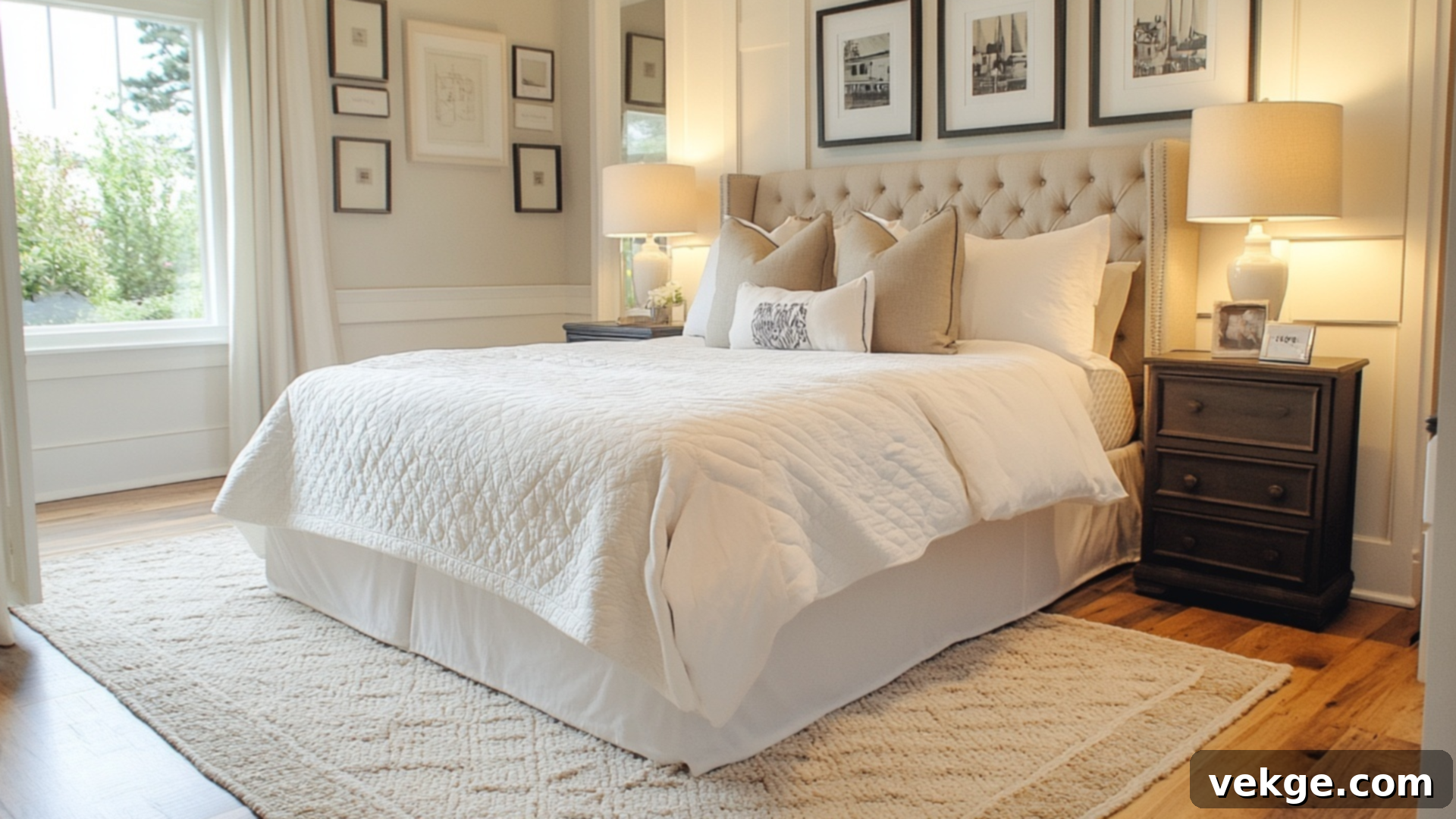
In a small square room, maximizing space while adhering to Feng Shui principles is key. Place your bed diagonally across from the door, ensuring it’s not directly in line with the entrance, but still allows a clear view. Position a solid headboard against the most supportive wall. Crucially, keep both sides of the bed easily accessible with matching, compact nightstands and lamps to maintain symmetry. Avoid placing any mirrors that reflect the bed, as this can amplify energy in a confined space. A soft, round rug under the bed can help ground the room and define the sleeping area. Utilize vertical storage like tall, narrow shelves or stylish storage bins along a far wall, away from the bed, to keep clutter contained and allow energy to circulate freely without making the room feel cramped.
2. Long Rectangular Room Layout
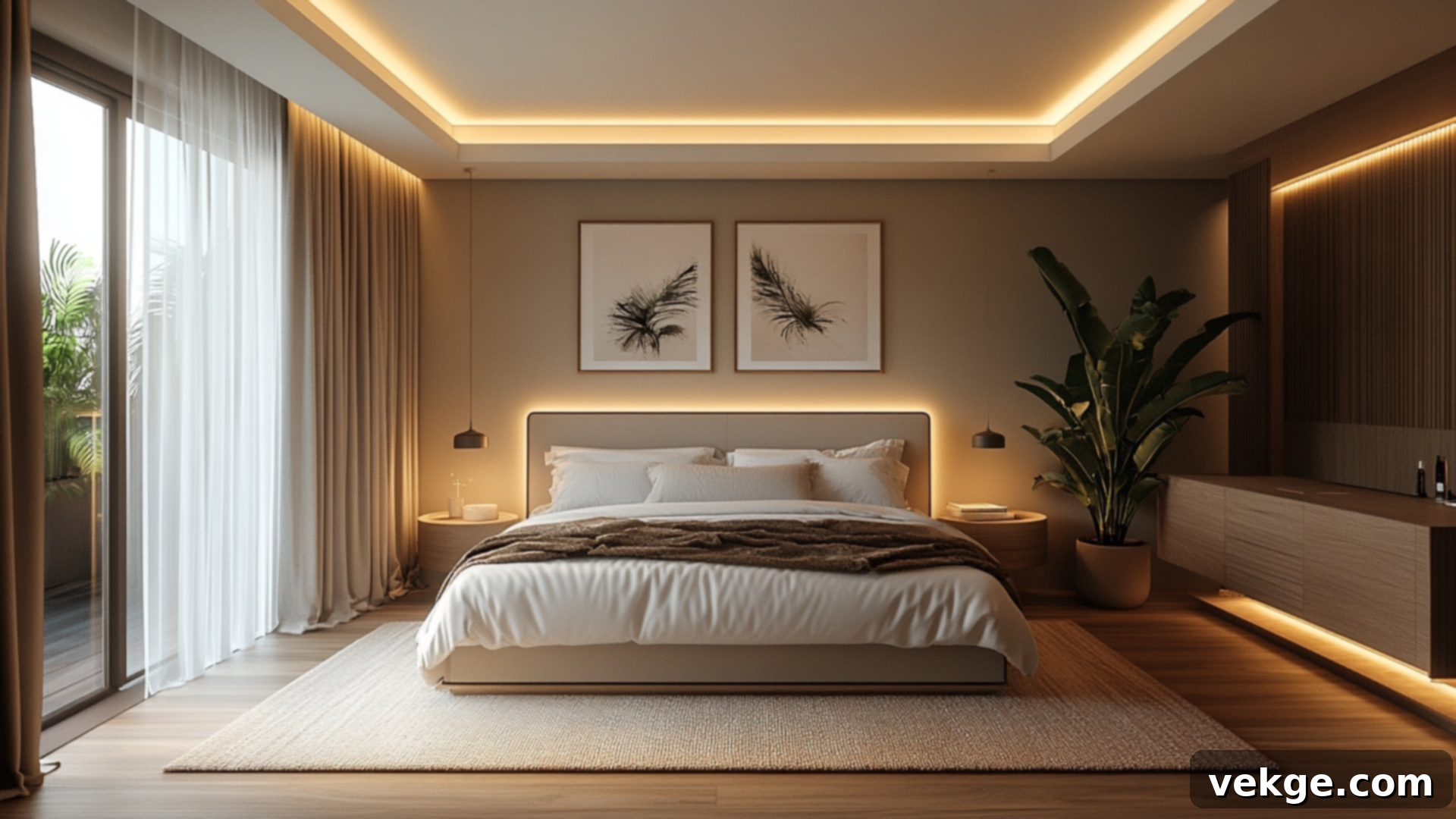
In a long, rectangular room, the goal is to break up the linear energy flow. Position your bed on one of the longer walls, ensuring it faces the far side of the room, providing a clear view of the door (commanding position). It’s paramount to keep the space underneath the bed completely empty to allow for free energy circulation. Use long, flowing curtains to visually soften the room’s elongated shape and add a touch of elegance. Place tall plants or inspiring artwork in the far corners of the room to prevent energy from feeling “stuck” or stagnant. Employ soft, diffused lighting near the bed and choose rounded nightstands or tables to avoid sharp corners, promoting a more gentle and harmonious environment. This helps to create a sense of intimacy and balance within a potentially overwhelming space.
3. Corner Door Room Layout
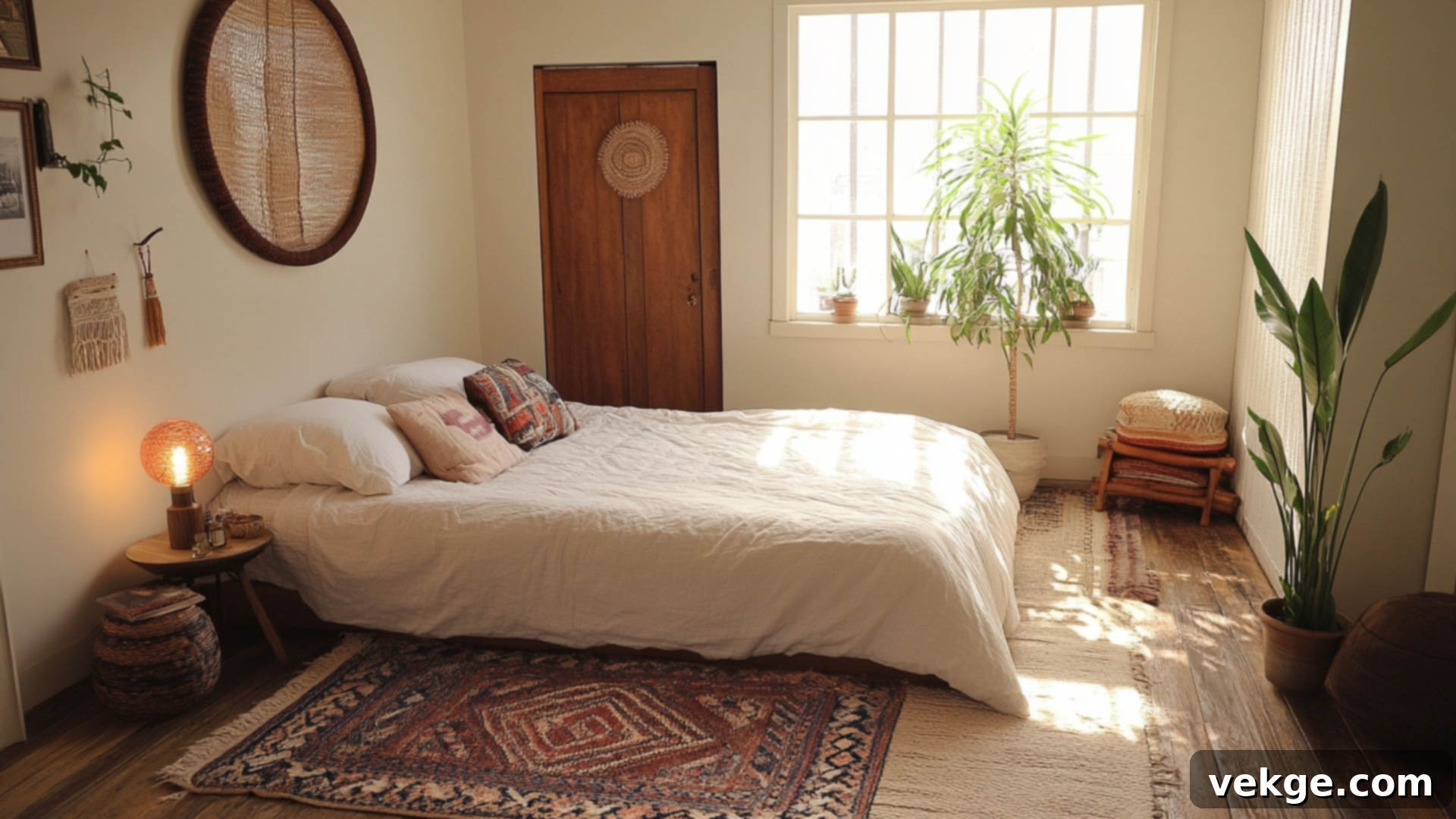
When your bedroom door is situated in a corner, it presents a unique challenge for bed placement. The ideal approach is to place the bed on the opposite wall, slightly angled so that you can still comfortably see the door without being directly in its path. This ensures you maintain a commanding view and a sense of security. Add soft rugs or comfortable floor cushions to balance the open space and create a cozy zone. A tall plant or an elegant lamp in the corner behind the door can help to lift and circulate potentially stagnant energy. Remember to place equal nightstands on both sides of the bed for symmetry and avoid hanging shelves or heavy pictures directly above the bed to maintain a feeling of lightness and safety.
4. Wide Room With Windows Layout

In a wide room with multiple windows, the challenge is to create a sense of enclosure and support. Place your bed in the center of the solid wall that does not contain windows or doors, utilizing a sturdy headboard for stability. It’s important to ensure that no window directly faces the foot of your bed, as this can lead to energy leakage and a feeling of exposure. Use soft, flowing curtains to soften the energy coming from the windows, offering both privacy and a gentle aesthetic. Avoid placing mirrors near the windows, which could reflect and amplify external energy. Incorporate balanced nightstands on either side of the bed, and consider adding a low bench or trunk at the foot of the bed. This addition helps to ground the space, visually connect the elements, and support a steady, nurturing energy flow throughout the room.
5. Shared Bedroom Layout

For a bedroom shared by two people, Feng Shui emphasizes balance, equality, and connection. Place the bed so that both sides are equally open and accessible, symbolizing an equal partnership. It is essential to have two identical lamps and two matching nightstands, avoiding single items that could suggest an imbalance. The bed should still be in a commanding position, facing the door but not directly in line with it, ensuring both occupants feel secure. Adorn the wall across from the bed with calming artwork or personal photos that evoke positive shared memories. Keep overall decor simple and ensure each person has designated space for their belongings. This thoughtful arrangement supports peace, harmony, and a balanced flow of energy between both individuals, fostering a strong and nurturing relationship within the shared space.
Avoiding Common Feng Shui Mistakes in Your Bedroom
To truly optimize the energy in your bedroom and create a haven for restorative sleep, it’s just as important to be aware of and avoid common Feng Shui pitfalls. These errors, often made unintentionally, can disrupt positive energy flow and negate the benefits of other good practices. Here are some significant mistakes to watch out for:
- Placing Furniture in the Path of Doorways or Windows: Blocking pathways with bulky furniture or objects impedes the natural flow of “Qi” (energy). This creates stagnation and can lead to a feeling of discomfort, frustration, and restriction. Ensure clear, open pathways into and around the room to invite smooth energy circulation.
- Choosing Dark, Overpowering Colors for Walls or Large Furnishings: While personal preference plays a role, excessively deep, heavy colors like dark red, black, or very deep purple can create a sense of oppression, heaviness, or intense energy that is counterproductive to rest. These colors can be stimulating rather than soothing. Instead, opt for lighter, calming tones (as discussed previously) to encourage deep relaxation and a sense of expansiveness.
- Positioning the Bed Directly Under a Window: Sleeping with your head directly under a window can make you feel exposed, unsupported, and vulnerable, as windows represent openness to the outside world and a lack of solid backing. This can lead to restless sleep and a feeling of insecurity. Always strive to place your bed against a solid wall to provide a sense of stability, protection, and strong energetic support.
- Overusing Metallic Decor or Sharp-Edged Objects: While metal elements have their place, an excessive amount of metallic decor or decorative items with sharp, pointy edges can create an imbalance of energy. Metal can be too stimulating and “cutting,” generating harsh “Sha Chi.” Instead, balance metallic accents with warm, earthy tones, soft textures, and natural materials to foster a more grounded and gentle environment.
- Neglecting to Address Room Odors or Stale Air: Lingering odors, stale air, or a general lack of freshness can significantly diminish positive energy flow and negatively impact your mood and sleep quality. Stagnant air contributes to stagnant energy. Ensure proper ventilation by regularly opening windows, using an air purifier, or diffusing calming essential oils (like lavender) to keep the room feeling fresh, light, and energetically vibrant.
By consciously avoiding these common Feng Shui mistakes, you can proactively create a peaceful, harmonious, and balanced bedroom that optimally promotes restful sleep, positive energy, and overall well-being. Attention to these details can make a profound difference in the comfort and energetic quality of your personal sanctuary.
Conclusion: Cultivate Your Sanctuary for Better Sleep and a Happier Life
Throughout this guide, I’ve shared invaluable insights into how positive energy placement through Feng Shui bedroom ideas can profoundly improve your sleep quality and significantly boost your overall well-being. It’s clear that transforming your bedroom into a serene sanctuary doesn’t require drastic measures or a hefty budget; often, it’s the thoughtful, simple changes that yield the most powerful results.
From strategically shifting your bed into a commanding position, to mindfully choosing calming colors and soft lighting, or diligently clearing away clutter and ensuring proper airflow, each adjustment contributes to a more peaceful and supportive bedroom environment. These principles work in harmony to create a space where you can truly unwind, allowing your body and mind to rest deeply and rejuvenate completely.
I encourage you to take a moment right now to look around your own sleeping space with fresh eyes. Consider which of these Feng Shui tips resonate most with you and seem most achievable. Remember, the journey towards a more harmonious home is personal, and it’s all about creating a space that genuinely feels right and uplifting for you. Trust your intuition and observe the subtle, yet powerful, shifts in your comfort and peace.
If you’re now feeling inspired and ready to explore more transformative Feng Shui tips and bring even greater balance and positive energy into other areas of your home, I invite you to delve into our other comprehensive blogs. Start making your space work for you today, and unlock the potential for a calmer mind, deeper sleep, and a happier, more balanced life!
